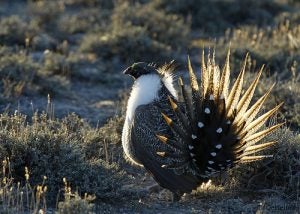
An icon of the sagebrush sea, the greater sage-grouse is a sight to behold. Males often gather in large numbers to woo females and strut with chests puffed and spiky tails fanned. (Photo credit: Tatiana Gettelman)
It was a sunny, cool morning – a typical September day in Colorado. I pulled up to the Rocky Mountain Arsenal National Wildlife Refuge and walked towards a stage where the state flags for Colorado, Nevada, Montana and Wyoming waved in the wind alongside the American flag.
It was a good morning. Then-Secretary of the Interior Department, Sally Jewell, had announced earlier that morning that the greater sage-grouse – a bird with habitat spanning parts of 11 western states – was “not warranted” for listing under the Endangered Species Act, thanks to one of the largest collaborative conservation efforts in America’s history.
A success story in the sagebrush sea
Sixteen million sage-grouse once roamed the American West. The Plain Indian tribes lived among the birds, hunting them for food and mimicking the males in their ceremonial dances. Meriwether Lewis spotted them “in great abundance” in 1805 during his expedition with William Clark, providing the first written account of the species.
As of 2010, there were approximately 200,000 to 500,000 birds remaining.









